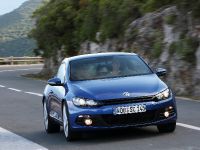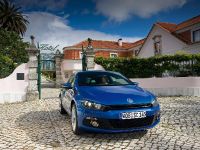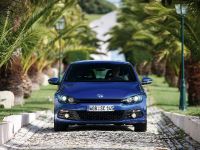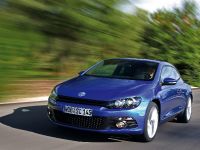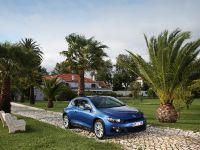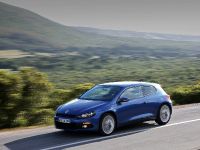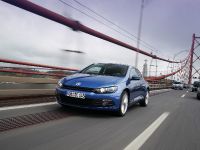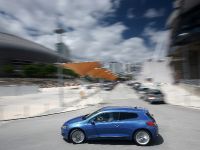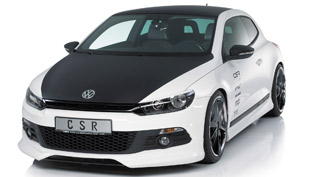To the Point: Scirocco
Scirocco is the right choice as an affordable sports car for every day of the year The countdown is running for the new era Scirocco: the third generation of the sports car will already be arriving on the market in August. Volkswagen is staging the comeback of a legend with the debut of the two-door car – Scirocco generations I and II wrote history as the most successful Volkswagen coupe of all time with about 800,000 units sold.
* Cult status. In particular, it is the original Scirocco presented in 1974 that has long held cult status. Because, in contrast to many of its competitors of that time, the Scirocco – designed by Giorgio Giugiaro – was an affordable car with everyday utility, and front-wheel drive also made it a safe sports car for use every day of the year.
Scirocco unites passion and logic
* Fascination. The new Scirocco is extending this tradition. It offers pure driving pleasure, a new powerful design, high-end technologies such as DCC adaptive chassis control and the new 7-speed DSG dual clutch transmission. Plus: exclusive use of efficient turbo engines with up to 147 kW / 200 PS power, space for four adults despite its sporty lines, an extremely high level of safety and the everyday utility that is typical of every Volkswagen. This mix of passion and logic costs far less than one might guess based on the car's key data.
* New paths. Although the third generation of the Scirocco follows exactly the same positioning as the first one, Volkswagen very intentionally avoided retro elements. In this regard too, the Scirocco of the year 2008 is a conceptually counterpart to the original version: because in the mid-1970s the successor to the Karmann Ghia also set out on new paths, both technically and visually.
Front end design of a new era
* High-sheen black headlamp housing. The third Scirocco is the first Volkswagen to sport the front end design of a new era. Especially characteristic here are the chrome lamp bodies and high-sheen black interior surfaces of the headlamp housings that are joined by the radiator grille cross bar that is also painted in high-sheen black.
* Flawless sports car fundamentals. The Volkswagen design team created a wagon-coupe based on flawless sports car fundamentals. This resulted in a side profile that had the potential to imbue this new Volkswagen too with a status that goes beyond class distinctions. Thanks to its long sweeping roofline and near-vertical rear window, it also frees up space for variability and up to 755 liters of cargo capacity.
* Crisp dimensions. Other benchmark figures of the new sports car also speak a clear language. With its short overhangs, the Scirocco efficiently utilizes its 2,578 millimeter wheelbase to offer ample space. The Volkswagen is 1,404 millimeters tall, exactly 4,256 millimeters long and its width measures 1,810 millimeters.
Four turbo engines at market introduction
* A lot of power for just a little fuel. One challenge in creating an affordable sports car involves the engines. On the one hand, they must absolutely be agile, yet it is also essential that they be economical and widely affordable. There are two approaches to resolving this apparent conflict Both of them have three letters: TDI and TSI – turbocharged diesel and gasoline direct injection engines.
* One TDI and three TSIs. At the market introduction Volkswagen will offer the Scirocco with two TSI engines (118 kW / 160 PS and 147 kW / 200 PS). Shortly thereafter, a TDI (common rail turbo-diesel, 103 kW / 140 PS) and another TSI (90 kW / 122 PS) will be added to the engine lineup. Decisive here is the fact that even the 122-PS base engine offers a maximum of torque at extremely low engine speeds (200 Newton-meter starting at 1,500 rpm). Its average fuel consumption of 6.1 liters per 100 kilometers shows considerable restraint.
* 5.4 to 7.7 liters fuel consumption. The combination of maximum torque and minimum consumption is a common theme running through the entire engine lineup. In the case of the latest TSI with 160 PS, 240 Newton-meter torque contrasts with just 6.5 liters super unleaded per 100 kilometers. And even on the 200-PS TSI with its considerable 280 Newton-meter of torque, fuel consumption is just 7.7 liters. As would be expected, the TDI also makes a brilliant showing here: 320 Newton-meter of powerful torque while being satisfied with just 5.4 liters of fuel. Incidentally, all engines up to 160 PS already satisfy the future Euro-5 emissions standard*.
Two crisply shifting dual clutch transmissions
* 6-speed and 7-speed DSG. Standard equipment on the Scirocco is the smoothly and precisely shifting 6-speed transmission. The DSG dual clutch transmission is offered as an option on the three engines starting at 140 PS. A 6-speed DSG is used with the TDI and the powerful 200 PS TSI. The 160-PS TSI distributes its power over an even broader range of gears with the 7-speed DSG.
Optional sport chassis with three level settings
* Clever Chassis. Ideally tailored to the Scirocco is the new DCC adaptive chassis control system. Not only is the damper characteristic controlled here, but also tuning of the electro-mechanical power steering. Adaptive chassis control offers the three programs Normal, Sport and Comfort. Significant here is the fact that adaptive chassis control improves the driving characteristics of the Scirocco full-time. That is, the suspension is continually adapted to the roadway and driving situation. The system also reacts to accelerator, brake and steering inputs. It is able to resolve the conflict in goals between a tight sport suspension and a comfortable one.
Standard features
* Full program. The new Scirocco is one of the most attractive sports cars in terms of price. And yet its standard features place it on the same level as far more expensive coupes. Always on board are 17-inch alloy wheels, height-adjustable driver and front passenger seats, leather steering wheel, parking brake handle and shifting lever grip, sport seats, split folding rear seatbacks, power windows, air conditioning, ESP, braking assistant, six airbags, power steering and of course a sport chassis. On the top 200 PS model, standard equipment also includes chrome tailpipes, a Titanium black roof liner and a sound generator.
Panorama vent sunroof
* Transparent roof. Supplying vast amounts of light to the interior is an optional large panorama vent sunroof that extends from the A-pillars to the B-pillars. At the press of the button the transparent roof opens up to 39 millimeters. When the sun is intense, a sunshade can be driven into place. But that is not likely to be necessary very often, since the glass of the panorama vent sunroof only transmits 8.2 percent of the UV radiation, 2.8 percent of the infrared radiation (heat) and 6.9 percent of the visible light.
Scirocco - Fact Sheet
Key aspects in alphabetical order
Automatic transmission: 6-speed and 7-speed DSG
Body: With panorama vent sunroof upon request
Cargo capacity: 292 liters to 755 liters
Character: Genuine, affordable sports car with space for four adults, status beyond class distinctions
Chassis: McPherson front suspension, four-link rear suspension, ESP is standard
Colors: Candy white, Rising blue metallic, Deep black pearl effect, Reflex silver metallic, Shadow blue metallic, Beryllium gray metallic, Dark maroon metallic, Opal silver metallic, Salsa red, Viper green metallic (the latter in homage to the first generation of Sciroccos)
Debut of generation I: 1974; 504,153 units built
Debut of generation II: 1981; 291,497 units built
Design: Visual look of flawless sports car fundamentals, first Volkswagen with new front end design, wagon-coupe with extremely long roof (1.8 meters). Design responsibility: Walter de Silva (Group), Klaus Bischoff (Brand)
Dimensions: 4,256 mm long, 1,810 mm wide, 1,404 mm tall, extremely wide tread width (front 1,569 mm, rear 1,575 mm)
Drive: Front-wheel
Engine power range: 90 kW / 122 PS to 147 kW / 200 PS, all engines are charged, all engines up to 160 PS satisfy Euro-5 emissions standard*
Engines – diesel (TDI): 103 kW / 140 PS, 125 kW / 170 PS
Engines – gasoline (TSI): 90 kW / 122 PS, 118 kW / 160 PS, 147 kW / 200 PS
Fuel consumption range: 5.4 to 7.7 liters fuel per 100 kilometers
High-tech driving systems: DCC adaptive chassis control, ACC automatic distance control (starting early 2009)
Infotainment: Two radio systems, two radio-navigation systems, 300 Watt Dynaudio sound system, MEDIA-IN port (USB)
Market introduction: August 29, 2008 in Germany and Great Britain, by November across Europe, in May 2009 in Japan
Production site: Volkswagen Autoeuropa – Automoveis Ltda. in Palmela, Portugal
Racing use: At the start of the 24-hour race on the Nurburgring in May 2008 with powerful 238 kW / 325 PS racing version; results: double victory in its class.
Safety: Six airbags, exceptionally rigid body, ESP, Isofix child seat mounting brackets, special pedestrian protection features, front passenger airbag can be deactivated (for rear-facing child seat), in case of crash: automatic activation of hazard flasher and interior lights, automatic door opening, automatic deactivation of fuel pump
Standard features: Include 17-inch alloy wheels, height-adjustable driver and front passenger seats, leather steering wheel and parking brake handle, newly designed sport seat system, split folding rear seatbacks, power windows, air conditioning, ESP, braking assistant, six airbags, power steering with countersteer feature, sport chassis
Standard transmission: 6-speed manual
* Due to current vehicle registration laws, the vehicles can only be registered for the current Euro-4 emission standard initially. It will then be possible for the car owner to re-classify or re-register the vehicle at additional charge.
